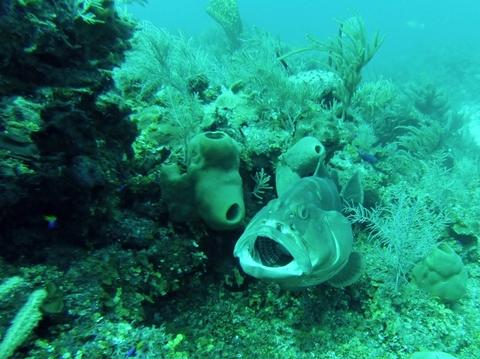The
Grouper Moon Project came to a close this week, and the greatest lesson learned was that in the field nothing always goes as planned. Whether from technical set-backs or nature creating its own designs, the best projects are those that can roll with the unexpected outcomes. Despite some strong winds and a the drop in the air temperature that made boat trips wet, bumpy and chilly, the underwater communication wires required new splicing repairs while we were on a remote island. But rolling with the seas, overall the week was a success for collecting the data about what we observed. But the numbers of Nassau grouper that arrived at the spawning site were lower than expected. Seven hundred grouper aggregating seem like a high abundance while diving with them, but it’s still far below than the 1000s of grouper that comprise the mass spawning event at Little Cayman. REEF science coordinator, Christy Semmes-Pattengill, and Brice Semmens of Scripps institute, contribute the low abundance to a lunar effect. This year, the full moon falls at the middle of the month for both January and February. This “split moon” gives rise to a false start for the spawning period. Some grouper showed up as the early arrivals, but until the mass of grouper arrive as expected next month in February, the main spawning event will not happen. Around the island, many of the local dive masters reported seeing their resident Nassau groupers still hanging around the reef sites, so it’s likely that the grouper were not going elsewhere to spawn. It’s interesting to think that perhaps there is a social effect based on a population threshold that will determine when these grouper will spawn. So why did some fish show up this month and not all of them? In nature, it’s usual to have outliers in the population that differ from the normal population – that’s what makes populations adapt to environmental events in the scheme of evolution.
Aside from the Nassau grouper aggregation, it’s speculated that other fish species may use the same site for their own spawning events. Located at the west end of the island where currents can converge, the site is unique in that it extends outward from the near shore as a plateau before it drops thousands of feet down to the abyss as a bluff. Hundreds of Horse-Eye jacks were seen in darkened body coloration and elicited rushes through the water. Dog snapper were seen in spawning groups of up to 17 individuals, while even Honeycomb cowfish were seen in pairs on the reef. Drifters, ring-like floating satellite links, were deployed to learn more about how the currents may act in favor at this site to recruit fish species that spawn there.
I leave the Grouper Moon project with a new perspective about how fascinating these fish are. As I spent hours of interaction with these creatures while counting them, I began to appreciate how charismastric these fish are to the reef. Watching a grouper lay gentle and still for a deep “dental” clean from tiny gobies, I felt a bond with their presence. Some members of the aggregation would follow me and prod for scaly body rubs, almost affectionately. It’s clear these fish fear little on the reef, which probably contributes to how vulnerable they are to human harvest. I do not like to personify nature, but after spending time with these fish and watching their behavior as they respond to their environment as well as divers, I ascend to my safety stop to contemplate whether they are as curious of me as I am of them.

